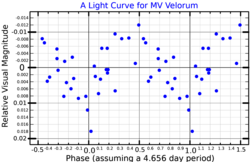HD 89890
| Observation data Epoch J2000 Equinox J2000 | |
|---|---|
| Constellation | Vela |
| Right ascension | 10h 20m 54.77319s[2] |
| Declination | −56° 02′ 35.5728″[2] |
| Apparent magnitude (V) | 4.50[3] |
| Characteristics | |
| Spectral type | B3 III + A0 IVpSi + A2 + K0 III[4] |
| B−V color index | −0.102±0.014 (A + B)[5] |
| Astrometry | |
| Radial velocity (Rv) | +10.4±2.8[5] km/s |
| Proper motion (μ) | RA: −7.5[6] mas/yr Dec.: +4.0[6] mas/yr |
| Parallax (π) | 2.6564 ± 0.2314 mas[2] |
| Distance | 1,200 ± 100 ly (380 ± 30 pc) |
| Absolute magnitude (MV) | −3.21 (A + B)[5] |
| Details | |
| A (HD 89890) | |
| Radius | 10.07±0.20[7] R☉ |
| Luminosity | 3,082.41[5] L☉ |
| Surface gravity (log g) | 3.00±0.03[7] cgs |
| Temperature | 15,000±150[7] K |
| Rotational velocity (v sin i) | 26.8±0.5[7] km/s |
| Other designations | |
| A+B: CPD−55 3286, HIP 50676, HR 4074[8] | |
| A: J Velorum, MV Velorum, HD 89890, SAO 237959, TYC 8604-975-1[8] | |
| B: SAO 237960, TYC 8604-2444-1[8] | |
| C: CD−55 3306, SAO 237958, TYC 8604-2137-1[8] | |
| Database references | |
| SIMBAD | HD 89890 (A) |
| HIC 50676 (A+B) | |
| TYC 8604-2444-1 (B) | |
| CD-55 3306 (C) | |
HD 89890 is the brightest member of a multiple star system with at least four components,[4] located in the southern constellation of Vela. It is visible to the naked eye with an apparent visual magnitude of 4.50.[3] The annual parallax shift of 2.6 mas[2] provides a distance estimate of around 1,200 light-years (370 parsecs). It is moving further away from Earth with a heliocentric radial velocity of +10 km/s.[5]
System
The Washington Double Star Catalog lists three visible components for this system. The brightest, component A, is of visual magnitude 4.50. Component B has a magnitude of 7.179,[9] and as of 2000 lies at an angular separation of 7.10″ from A, along a position angle (PA) of 102°. Component C is a magnitude 9.125 star[9] at a separation of 36.20″ from A at a PA of 191°. The physical link between the stars was described on the basis of their dynamic parallax and mean velocities.[10] The three components A, B and C have Gaia Data Release 2 parallaxes of 2.6564±0.2314 mas, 2.1771±0.0490 mas, and 1.6097±0.0400 mas, respectively.[2]
Properties
Component A has a stellar classification of B3 III, and is categorized as a Be star. It shows photometric variations with multiple periods around 4.6 days and line-profile variations with a period of 2.318 days. The radial velocity of this star is constant.[4] It has 10[7] times the Sun's radius and shines with 3,082[5] times the Sun's luminosity from its photosphere at an effective temperature of 15,000 K.[7]
The component B shows a variation in spectra consistent with being a double-lined spectroscopic binary. The brighter member (Ba) is a silicon star with a class of A0 IVpSi, while the fainter component (Bb) is of type A2. Component C has a class of K0 III, indicating it is an evolved giant star. The measured effective temperature of C is 5,500 K. The fact that component A most likely shares a common origin with C suggests that the former is much older than expected, and may actually be a blue straggler formed from the merger of a close binary. This could have been caused by the gravitational influence of an unseen companion of A.[4]
Text is available under the CC BY-SA 4.0 license; additional terms may apply.
Images, videos and audio are available under their respective licenses.

